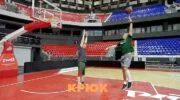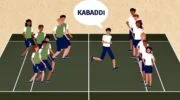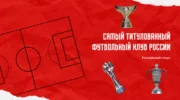In the article “Soccer” we will tell you about the most popular game on the planet. In addition to the history of the development of the game, you will also learn about the secret of the “Dry Leaf” kick.
#Football #SoccerHistory #Soccer #AboutSoccer
Who do you think we should be grateful to for the invention of soccer? You would say, of course, England. And that’s the wrong answer. Do you think that before the English no one kicked a ball around a field? Sure they did ![]()
Judging by extant drawings, the ancient Egyptians were big fans of this sport, and it was 4,500 years ago. And 2,000 years ago, the ball game was invented by the Chinese and called “Tsu Chu”, where “Tsu” means kicking the ball and “Chu” means stuffed leather ball. This game even had a counterpart to the modern goal.
Games similar to modern soccer were among the American Indians, the Eskimos and the inhabitants of Australia, they were in Russia. For example, the old game “Shalyga”. In it the players had to drive the ball into the territory of the opponent.
Long before the appearance on the map of the state of “Great Britain” mankind pretty well know how to handle a ball, but the rules of the game of modern soccer, really, have appeared in England, so it is officially considered the birthplace of soccer.
As in many other countries in our homeland, soccer is one of the most beloved sports games and the most popular sport. We also have our own recognized soccer masters.

Every soccer fan from Alaska to Brazil knows the name of Lev Yashin, the legendary Soviet soccer player. Lev Yashin is recognized as the best goalkeeper of the 20th century. He is the only goalkeeper on the planet to receive the most prestigious award for soccer players – the Golden Ball.
Modern soccer is unthinkable without clear rules. Thanks to them the referee finds an accurate and fair solution to any problem. On the rules of soccer we will focus in more detail in a separate article.
Any match consists of two periods (halves) of 45 minutes each. The break between halves is 15 minutes. After the break, the soccer teams change goalposts. There are 11 players from each team (10 field players and one goalkeeper). The goalkeeper is the only player who is allowed to play with his hands, but only in the penalty area near his goal.
Each of the 10 field players has a different position. “Defenders” reflect the opponent’s attacks and are usually in their own half of the field. “Midfielders” are located in the middle of the field and assist the defenders, pass to the forwards, and participate in their team’s attacks. The “attackers” are the most active and penetrating players. They are closest to the opponent’s goal and operate there. Their main task is to take effective actions that will lead to a goal.
If the game is tied after regular time, an extra time of two more 15 minutes may be scheduled. But if they also do not determine the winner, then a “penalty shootout” takes place. A penalty shootout is a series of five shots from each team from the 11-meter mark. Extra time and a penalty shootout are not always awarded, but only in decisive matches. In normal games the contest may end in a draw.
Soccer is a very strict discipline and breaking the rules is not only punishable for a player, but also penalizes the whole team. For example, if a player tries to hold, push or hit an opponent, the injured team will be penalized. One of the most serious violations is playing with the hands of a field player.
In addition to penalty kicks, there are penalties such as warnings and removal of the player from the field. So it is not easy for offenders in this sport.
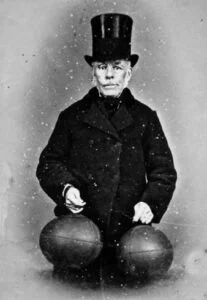
During a soccer match, everyone’s attention is focused on the soccer ball. The first balls were stuffed with different soft materials and covered with leather. They did not hold their shape well and often burst from a hard blow. But in the mid-19 th century soccer tackle literally got a new life.
In 1855 Charles Goodyear made the first rubber ball, and seven years later Richard Lindon has invented a rubber inflatable tube for it. The balls became durable and truly round.
Until the middle of the last century, the “round” was made of leather and laced with leather threads. When it rained, such balls would get wet and heavy. Thus athletes began to prefer synthetic shells, durable, lightweight and not getting wet.
The color of a soccer ball is mostly black and white. However, this was not always the case. It wasn’t until the 1960s of the 20th century, when balls made of synthetic materials appeared, that they were made of docked 5 and 6 angles. This produced a perfect sphere. Modern types consist of 20 6-cornered and 12 5-cornered balls.

That’s how the ball is played on the field, and not just played. The team together with the coach builds their tactical system, attack and defense to use all their capabilities and outplay their opponent.
Soccer tactics is a real art. Because of this soccer is like a game of chess. In addition to team tactics there are also individual tactics. This includes feints.
There are many types of kicks in soccer, and the most insidious one is called the “dry leaf“. What is its tricky part?
On June 3, 1997, Brazilian Roberto Carlos kicked a free kick into the goal of the French national team. The ball, sent by Roberto, strongly evaded to the right, and then abruptly changed its trajectory, bypassed the goalkeeper and flew into the net.
The stands exploded with applause, and scientists rushed to computers to find a physical explanation for the phenomenal behavior of the ball. And the scientists found the answer. Carlos’s shot was a kind of twist kick, and the sharp deviation to the left at the end of the kick was explained by the abnormally high velocity. So why does a twisting kick give the ball such a trajectory?
Answer: The reason for the deflection of the projectile lies in the Magnus effect, which is based on Daniel Bernoulli’s law.
To make sense of it, you have to remember what happens when you accelerate well on a windless day on a bicycle. You begin to be blown around by the oncoming flow of air. The same thing happens to the ball. And if it’s spinning, the surface of the ball engages nearby layers of air in rotation through friction.
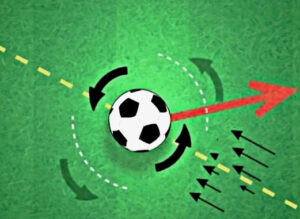
On a hard hit, the ball is spun counterclockwise by the player. This rotation in flight and the resistance of the air flow coming at it create the surrounding vortices. This is the Magnus effect. Vortices create a pressure differential around the ball and due to them there is a transverse (deflecting) force, which changes its trajectory.
This is the secret of the “Dry Leaf” kick. We can only marvel at the accuracy of Roberto Carlos, who was able to “by eye” estimate the amount of deflection of the ball and was able to give it the necessary force of rotation.
Soccer is a team game in which the actions of each player are crucial. A team player always participates in coordinated actions, acts in the interest of the team and is responsible to it.
If you decide to become a soccer player, it is worth working on character traits such as discipline, organization and the ability to act together. Soccer will thank you and give you speed, endurance, excellent reaction, agility, and, of course, victory.
You can join the soccer section from the age of 6 to 9 years, but you can start even later, especially if the coach approves of the general physical preparation.
If you decide to do soccer thoroughly, keep in mind that you need special equipment. These are cleats, socks, shorts and t-shirts. You’ll also need a tracksuit for training.
The main thing is not the uniform, but the desire to train and the love for the game of “soccer”.
A brief history of soccer
FAQs
What is soccer?
Soccer is a game sport in which players use individual skill or team tactics to attempt to score the maximum number of goals against an opponent. It has been part of the Olympic program since 1900 and is managed by the International Football Federation (FIFA).
Why are there 11 players on the soccer team?
The first rules of the game of soccer were written in 1846 by representatives of colleges in England. Teams for soccer were formed from the popular student game of cricket. Student rooms in dormitories accommodated 11 people. Thus, we can conclude that the number of players was borrowed from the game of cricket, so as not to disrupt the already formed teams. And 11 players so that the student rooms could compete with each other, one room - one team.
Why isn't there a British national team in soccer?
The British Football Associations (England, Scotland, Wales and Northern Ireland) were founded as independent organizations between 1863 and 1880, 16 years before the first Olympic Games. The Olympic Committee banned professional athletes from the games in 1972 and had to disband the team. The British team had not been successful at the Olympics for a long time, and the emerging contradictions among the associations took place more and more. It was politically decided to present one team from each country in order to increase the chances of winning, to increase the prestige of the association and to eliminate the controversy.
Who scored the most goals in soccer?
Soccer players ranked by career goals: 1) Cristiano Ronaldo (819 goals); 2) Lionel Messi (785 goals); 3) Pele (762 goals); 4) Romario (755 goals); 5) Ferenc Puskás (729 goals). The ranking is dynamic, as Ronaldo and Messi continue to perform. The ranking includes goals that were scored at the professional level.


